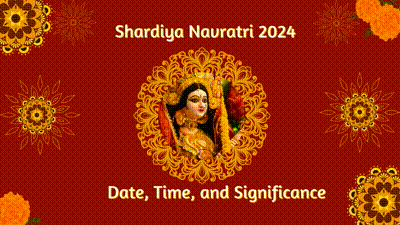Shardiya Navratri is one of the most important and widely celebrated Hindu festivals. It is dedicated to worshipping the nine forms of Goddess Durga. The word “Navratri” translates to “nine nights,” during these days, devotees engage in fasting, prayers, and celebrations to honour the divine feminine energy. Shardiya Navratri falls in the month of Ashwin (September-October) and marks the beginning of the festive season in India, leading up to Dussehra and Diwali.
In 2024, Shardiya Navratri will hold great spiritual significance, and devotees from all over the world are eagerly looking forward to the celebrations.
Shardiya Navratri 2024 Dates and Times
Shardiya Navratri 2024 will commence on Sunday, 3rd October 2024, and conclude on Tuesday, 12th October 2024. Each of the nine days is dedicated to one form of Goddess Durga, with specific rituals and prayers performed for her blessings.
Pratipada (Day 1): October 03, 2024
Dwitiya (Day 2): October 04, 2024
Tritiya (Day 3): October 05, 2024
Chaturthi (Day 4): October 06, 2024
Panchami (Day 5): October 07, 2024
Shashthi (Day 6): October 08, 2024
Saptami (Day 7): October 09, 2024
Ashtami (Day 8): October 10, 2024
Navami (Day 9): October 11, 2024
Vijaya Dashami (Dussehra): October 12, 2024
Pratipada (Day 1): Sunday, 3rd October 2024
The first day is marked by the sthapana of the Kalash, also known as Ghatasthapana and the invocation of Goddess Shailputri.
Ghatasthapana Muhurat – 06:15 AM to 07:22 AM (Duration – 01 Hour 06 Mins)
Ghatasthapana Abhijit Muhurat – 11:46 AM to 12:33 PM (Duration – 00 Hours 47 Mins)
Ashtami (Day 8): Sunday, 10th October 2024
One of the most significant days of Navratri, Durga Ashtami, is dedicated to Goddess Mahagauri. Devotees perform special prayers and fasts.
Navami (Day 9): Monday, 11th October 2024
Maha Navami, the concluding day of the nine-day festival, is devoted to Goddess Siddhidatri. It is a day of celebration and offering food to young girls, symbolizing the goddess herself.
Dussehra (Vijayadashami): Tuesday, 12th October 2024
The festival concludes with Vijayadashami or Dussehra, celebrating the victory of good over evil, symbolized by Lord Rama’s victory over Ravana.
History of Shardiya Navratri
The origin of Navratri can be traced back to ancient times and is deeply rooted in Hindu mythology. The festival celebrates the victory of Goddess Durga over the demon Mahishasura, symbolizing the triumph of good over evil. According to legend, Mahishasura, a powerful demon, was granted immortality by Lord Brahma because no man or god could defeat him. Empowered by this boon, Mahishasura wreaked havoc in the heavens and Earth.
To restore peace, the gods combined their powers to create Goddess Durga, a divine warrior with the strength and wisdom to defeat Mahishasura. After nine days of fierce battle, Goddess Durga finally vanquished the demon, and these nine days came to be celebrated as Navratri.
Each day of Navratri is dedicated to a different form of Goddess Durga, representing various aspects of her power and grace, such as Shailputri, Brahmacharini, Chandraghanta, Kushmanda, Skandamata, Katyayani, Kalaratri, Mahagauri, and Siddhidatri.
Significance of Shardiya Navratri
Shardiya Navratri has immense religious and cultural significance, as it represents the victory of righteousness and divine feminine energy. The festival is observed with great devotion, especially in North India, where temples are adorned with lights and people come together to celebrate with music, dance, and vibrant rituals.
Here are some critical aspects of Shardiya Navratri’s significance:
Spiritual Cleansing: Navratri is a time for introspection and spiritual cleansing. Fasting, meditation, and prayer help devotees purify their minds and bodies, bringing them closer to the divine.
Empowerment of Women: Goddess Durga symbolizes women’s strength and power. Navratri celebrates divine feminine energy, emphasizing women’s importance in society and their ability to protect and nurture.
Celebration of Good Over Evil: The festival commemorates the victory of good over evil, reminding people of the importance of righteousness, truth, and moral values.
Cultural Unity: Shardiya Navratri brings people together across communities to celebrate with joy, regardless of regional differences. In Gujarat, the festival is marked by Garba and Dandiya Raas, while in West Bengal, it coincides with Durga Puja, a grand celebration of Goddess Durga’s victory over Mahishasura.
New Beginnings: Navratri is also considered an auspicious time for new beginnings. Many people start new ventures or projects or make significant life decisions during this time, as it is believed that Goddess Durga’s blessings will ensure success and prosperity.
Rituals and Practices During Shardiya Navratri
Ghatasthapana: On the first day of Navratri, devotees perform Ghatasthapana, a ritualistic Kalash (pot) installation symbolizing the goddess. It is filled with water, decorated with mango leaves, and placed in the prayer room. This ritual marks the beginning of the nine days of worship.
Fasting: Many devotees observe fasts during Navratri, consuming only satvik (pure) food like fruits, nuts, and dairy products. Fasting is believed to cleanse the body and soul, making focusing on prayers and meditation easier.
Chanting and Meditation: Devotees chant mantras and perform daily pujas to invoke the blessings of Goddess Durga. Meditation and reciting the Durga Saptashati, a scripture that narrates the goddess’s victory over evil, are common practices during Navratri.
Kanya Puja: On the eighth or ninth day, devotees perform Kanya Puja, a ritual that involves worshipping young girls, symbolizing the nine forms of Durga. They are offered special food, gifts, and blessings.
Vijayadashami/Dussehra: The festival culminates in Dussehra, celebrating the triumph of good over evil. Effigies of Ravana, the demon king, are burned in grand processions, symbolizing Lord Rama’s victory over him.
Conclusion
Shardiya Navratri 2024 is a time for spiritual growth, devotion, and celebration. It offers an opportunity to connect with the divine feminine energy, reflect on one’s inner strength, and celebrate the ultimate victory of good over evil. By observing Navratri’s rituals and traditions, devotees seek Goddess Durga’s blessings for health, prosperity, and happiness in their lives.
Navratri’s vibrant and joyful spirit fills the air as the festive season approaches, reminding us of the power of faith and the significance of moral and spiritual values.







